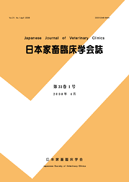Volume 31, Issue 3
Displaying 1-8 of 8 articles from this issue
- |<
- <
- 1
- >
- >|
Original Article
-
2008Volume 31Issue 3 Pages 137-142
Published: December 31, 2008
Released on J-STAGE: May 16, 2013
Download PDF (56K) -
2008Volume 31Issue 3 Pages 143-147
Published: December 31, 2008
Released on J-STAGE: May 16, 2013
Download PDF (58K)
Case Report
-
2008Volume 31Issue 3 Pages 148-153
Published: December 31, 2008
Released on J-STAGE: May 16, 2013
Download PDF (100K) -
2008Volume 31Issue 3 Pages 154-159
Published: December 31, 2008
Released on J-STAGE: May 16, 2013
Download PDF (70K)
Note
-
2008Volume 31Issue 3 Pages 160-164
Published: December 31, 2008
Released on J-STAGE: May 16, 2013
Download PDF (48K)
Clinical Technique and Procedure
-
2008Volume 31Issue 3 Pages 165-168
Published: December 31, 2008
Released on J-STAGE: May 16, 2013
Download PDF (61K)
Special Lecture
-
2008Volume 31Issue 3 Pages 169-173
Published: December 31, 2008
Released on J-STAGE: May 16, 2013
Download PDF (284K) -
2008Volume 31Issue 3 Pages 174
Published: December 31, 2008
Released on J-STAGE: May 16, 2013
Download PDF (12K)
- |<
- <
- 1
- >
- >|
